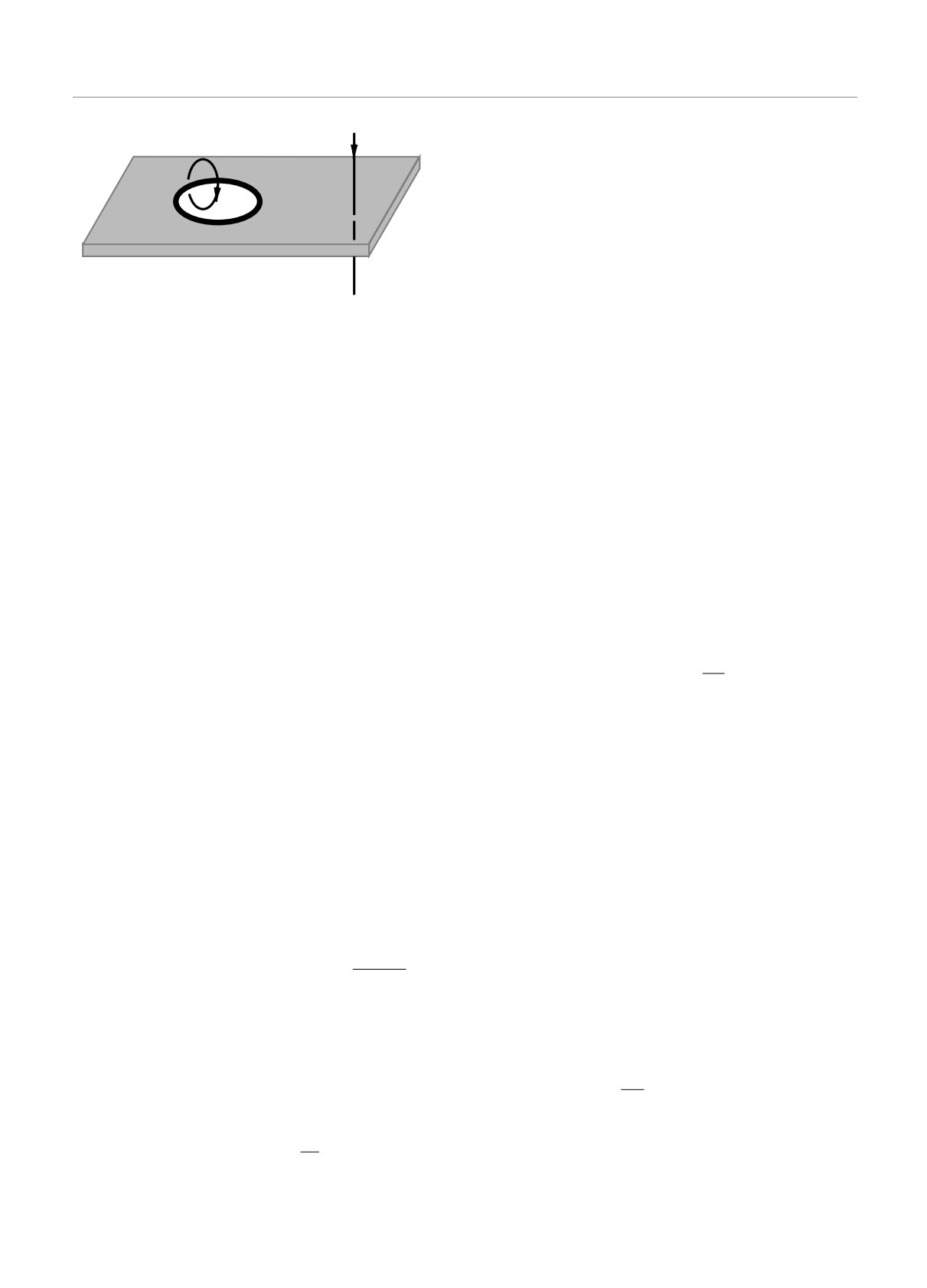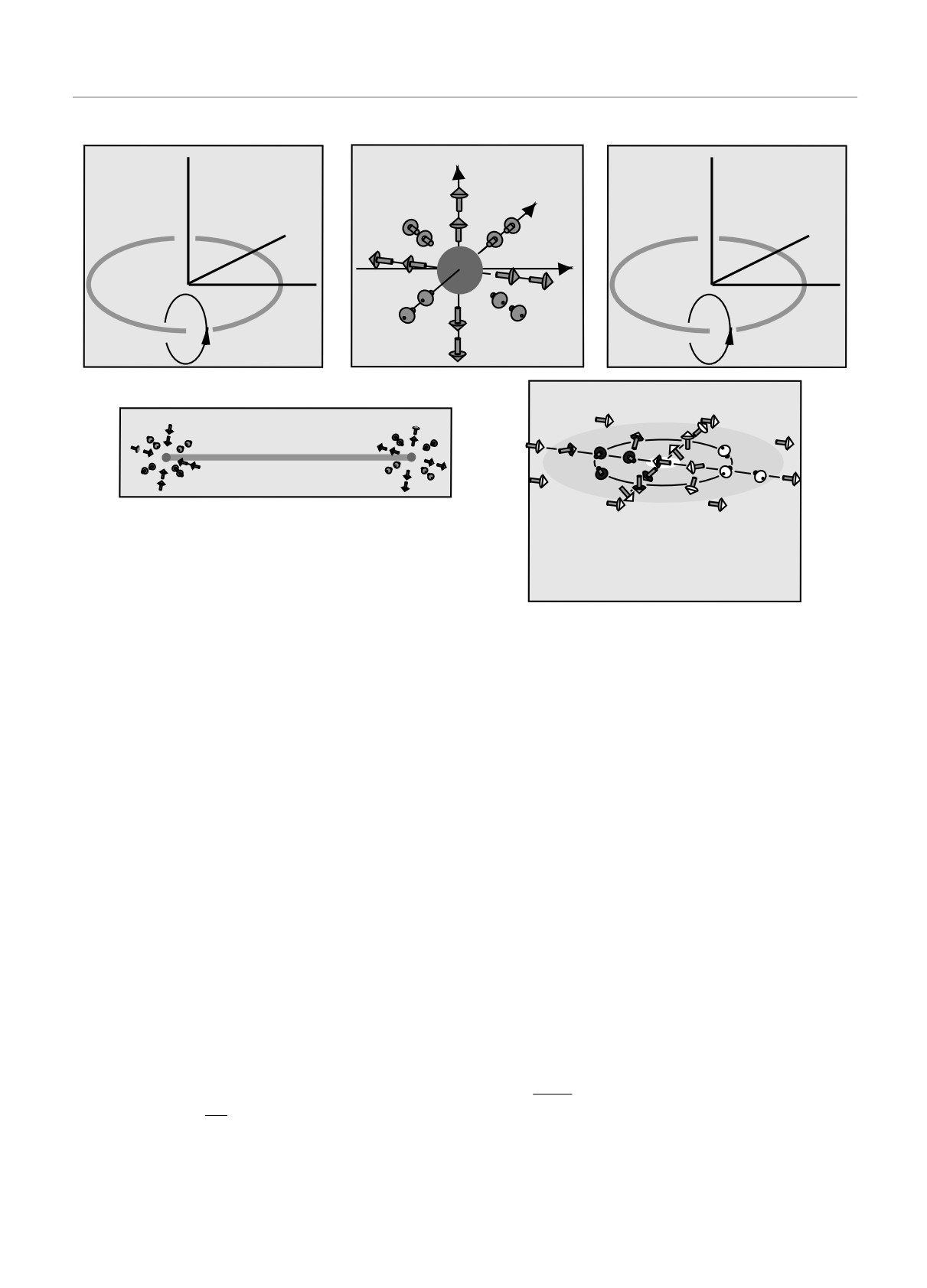ЖЭТФ, 2019, том 156, вып. 4 (10), стр. 700-706
© 2019
TOPOLOGICAL SUPERFLUIDS
G. E. Volovik*
Low Temperature Laboratory, Aalto University
FI-00076, Aalto, Finland
Landau Institute for Theoretical Physics, Russian Academy of Sciences
142432, Chernogolovka, Moscow Region, Russia
Received April 4, 2019,
revised version April 4, 2019
Accepted for publication April 5, 2019
Contribution for the JETP special issue in honor of I. M. Khalatnikov’s 100th anniversary
DOI: 10.1134/S0044451019100110
the ground state of these systems. This includes in par-
ticular the existence of the topologically stable nodes in
There are many topological faces of the superfluid
the fermionic spectrum in bulk and/or on the surface of
phases of3He. These superfluids contain various topo-
superfluids. It appeared that the superfluid phases of
logical defects and textures. The momentum space
liquid3He serve as the clean examples of the topologi-
topology of these superfluids is also nontrivial, as well
cal matter, where the momentum-space topology plays
as the topology in the combined (p, r) phase space,
an important role in the properties of these phases.
giving rise to topologically protected Dirac, Weyl, and
In bulk liquid3He, there are two topologically dif-
Majorana fermions living in bulk, on the surface, and
ferent superfluid phases,3He-A and3He-B [6]. One
within the topological objects. The nontrivial topology
is the chiral superfluid3He-A with topologically pro-
leads to different types of anomalies, which extend the
tected Weyl points in the quasiparticle spectrum. In
Landau-Khalatnikov theory of superfluidity in many
the vicinity of the Weyl points, quasiparticles obey the
different directions.
Weyl equation and behave as Weyl fermions, with all
Superfluid phases of 3He discovered in 1972 [1]
the accompanying effects such as chiral anomaly, chiral
opened the new area of the application of topologi-
magnetic effect, chiral vortical effect, etc. The Adler-
cal methods to condensed matter systems. Due to
Bell-Jackiw equation, which describes the anomalous
the multi-component order parameter which character-
production of fermions from the vacuum, has been ver-
izes the broken symmetries in these phases, there are
ified in experiments with skyrmions in3He-A [7]. An-
many inhomogeneous objects — textures and defects
other phase is the fully gapped time reversal invariant
in the order parameter field — which are protected by
superfluid3He-B. It has topologically protected gapless
topology and are characterized by topological charges.
Majorana fermions living on the surface.
Among them there are quantized vortices, skyrmions
The polar phase of3He stabilized in3He confined
and merons, solitons and vortex sheets, monopoles and
in the nematically ordered aerogel [8] contains Dirac
boojums, Alice strings, Kibble walls terminated by Ali-
nodal ring in the fermionic spectrum.
ce strings, spin vortices with soliton tails, etc. Some
The classification of the topological objects in the
of them have been experimentally identified [2-5], the
order parameter fields revealed the possibility of many
others are still waiting for their creation and detection.
configurations with nontrivial topology, which are de-
The real-space topology, which is responsible for the
scribed by the homotopy groups and by the relative
topological stability of textures and defects, has been
homotopy groups. Some of the topological defects and
later extended to the topology in momentum space,
topological textures are shown in Fig. 1.
which governs the topologically protected properties of
All three superfluid phases discussed here are the
spin-triplet p-wave superfluids, i.e., the Cooper pair
* E-mail: volovik@boojum.hut.fi
has spin S = 1 and orbital momentum L = 1. The
700
ЖЭТФ, том 156, вып. 4 (10), 2019
Topological superfluids
vs
c
a
b
3He-A
d
e
HQV
3He-B
f
g
Fig. 1. (Color online) Some topological objects in topological superfluids. (a) Vortex-skyrmions with two quanta of circulation
(N = 2) in the chiral superfluid3He-A. (b) Interface between3He-A and3He-B in rotation: lattice of skyrmions with N = 2 in
3He-A transforms to the lattice of singly quantized vortices (N = 1) in3He-B. Each skyrmion with N = 2 splits into two merons
with N = 1 (Mermin - Ho vortices). The Mermin-Ho vortex terminates on the boojum — the surface singularity which is the
analog of the Dirac monopole terminating the3He-B string (the N = 1 vortex). (c) Vortex sheet in3He-A. (d) Elements of the
vortex sheet: merons with N = 1 within topological soliton in3He-A. (e) Hedgehog-monopole in the
d-vector field in3He-A.
(f) Singly quantized vortex (N = 1) with spontaneously broken axial symmetry in3He-B as a pair of half-quantum vortices
(N = 1/2) connected by non-topological (dark) soliton. Such vortex has been identified due to Goldstone mode associated with
the spontaneously broken axial symmetry of the vortex core — the twist oscillations of the vortex core propagating along the
vortex line. This Figure is also applicable to the N = 2 vortex in3He-B, which consists of two composite objects — spin-mass
vortices connected by the topological soliton. (g) Half-quantum vortices (HQV) in the polar phase of3He, which in a tilted
magnetic field are connected by the topological spin soliton. Red arrows show direction of magnetic field, and blue arrows show
direction of spin-nematic vector
d, which rotates by π around each half-quantum vortex
order parameter is given by 3 × 3 matrix Aαi (see
Aαi = ΔAeiΦ
dα(êi1 + iêi2),
l=ê1 ×ê2,
(1)
below Eq. (11)), which transforms as a vector under
where
d is the unit vector of the anisotropy in the spin
SO(3)S spin rotations (first index) and as a vector un-
space due to spontaneous breaking of SO(3)S symme-
der SO(3)L orbital rotations (second index). The order
try;
ê1 and ê2 are mutually orthogonal unit vectors;
parameter Aαi comes as the bilinear combination of the
andˆl is the unit vector of the anisotropy in the orbital
fermionic opertators, Aαi ∝ 〈ψσα∇iψ〉, where σα are
space due to spontaneous breaking of SO(3)L symme-
Pauli matrices for the nuclear spin of3He atom.
ˆ-vector also shows the direction of the or-
try. The
bital angular momentum of the chiral superfluid, which
In the ground state of3He-A, the order parameter
emerges due to spontaneous breaking of time reversal
matrix has the form
symmetry.
701
G. E. Volovik
ЖЭТФ, том 156, вып. 4 (10), 2019
In the chiral superfluid, the superfluid velocity vs
N = 1/2 — the condensed matter analogs of the Alice
of the chiral condensate is determined not only by the
string in particle physics, in which
d changes sign when
condensate phase Φ, but also by the orbital triad ê1,
circling around the vortex:
ê2, andl:
(
)
ℏ
(
)
vs =
∇Φ + êi1∇êi2
,
(2)
φ
φ
2m
d(r)eiΦ(r) =
x cos
+ ŷ sin
eiφ/2.
(6)
2
2
where m is the mass of the3He atom. In non-chiral
superfluids, the vorticity is presented in terms of the
When the azimuthal coordinate φ changes from 0 to
quantized singular vortices with the phase winding
2π along the circle around this object, the vector
d(r)
ΔΦ = 2πN around the vortex core. In chiral superfluid
changes sign and simultaneously the phase Φ changes
3He-A, the vorticity can be continuous. The continu-
by π, giving rise to N = 1/2. The half-quantum vor-
ous vorticity is represented by the texture of the unit
tices have been stabilized only recently and in a dif-
vectorˆl according to the Mermi- Ho relation
ferent phase — in the polar phase of3He confined in
ℏ
aerogel [4].
∇×vs =
eijkli∇lj × ∇lk .
(3)
4m
In the ground state of3He-B, the order parameter
matrix has the form
Vorticity is created in the rotating cryostat. In
3He-A, the continuous textures are more easily cre-
Aαi = ΔBeiΦRαi ,
(7)
ated than the singular objects with the hard core of
the coherence length size ξ, which formation requires
where Rαi is the real matrix of rotation, RαiRαj = δij .
overcoming of large energy barrier. That is why the
Vorticity in the non-chiral superfluid is always singu-
typical object which appears under rotation of cryostat
lar, but it is also presented in several forms. Even the
with3He-A is the vortex-skyrmion. It is the continuous
N = 1 vortex, where Φ(r) = φ, has an unusual struc-
texture of the orbital
l-vector in Fig. 1a without any
ture of the singular vortex core. The first order phase
singularity in the order parameter fields. This texture
transition has been observed, at which the vortex core
represents the vortex with doubly quantized (N = 2)
becomes non-axisymmetric, i. e., the axial symmetry of
circulation of superfluid velocity around the texture,
∮
the vortex is spontaneously broken in the vortex core.
dr · vs = N κ, where κ = h/2m is the quantum of
The Goldstone mode associated with this symmetry
circulation. The vortex-skyrmions have been identified
breaking was experimentally identified. On the other
in rotating cryostat in 1983. They are described by two
side of the transition, at high pressure, the structure
topological invariants, in terms of the orbital vector
l
of the vortex core in3He-B is axisymmetric, but it is
and in terms of the spin nematic vector
d:
also nontrivial. In the core, the discrete symmetry is
(
)
∫
1
∂l
∂l
1
spontaneously broken. As a result, the core does not
ml =
dx dyl·
×
=
N,
(4)
4π
∂x
∂y
2
contain the normal liquid, but is occupied by the chi-
ral superfluid — the A-phase of3He. The phenomenon
(
)
∫
of the additional symmetry breaking in the core of the
1
∂d
∂d
md =
dx dy
d·
×
(5)
topological defect has been also discussed for cosmic
4π
∂x
∂y
strings — the so-called Witten string.
In a high magnetic field, the vortex lattice consists
In the ground state of the polar phase, the order
of isolated vortex-skyrmions with N = 2, ml = 1, and
parameter matrix has the form
md = 0. In the low field, when the magnetic energy
is smaller than the spin-orbit interaction, the vortex-
Aαi = ΔP eiΦ
dα zi ,
(8)
skyrmion with md = ml = 1 becomes more prefer-
able. The first order topological transition, at which
where axis z is along the nafen strands. Topology of po-
the topological charge md of the skyrmion changes from
lar phase in nafen suggests existence of the half-quan-
0 to 1, has been observed in acoustic experiments. In
tum vortices, which have been observed in the NMR
1994, new type of continuous vorticity has been ob-
experiments. Fig. 1g shows a pair of half-quantum vor-
served in3He-A: the vortex texture in the form of the
tices in transverse magnetic field (red arrows).
vortex sheet, the topological soliton with kinks, the
Later it was found that the half-quantum vor-
Mermin-Ho vortices with N = 1 (Fig. 1d).
tices survive the phase transition to 3He-B, where
In addition to continuous vortex textures, the ro-
the half-quantum vortex is topologically unstable. In
tating state of3He-A may consist of the singular vor-
the B-phase, the half-quantum vortices pinned by the
tices with N = 1 and the half-quantum vortices with
strands of nafen become the termination lines of the
702
ЖЭТФ, том 156, вып. 4 (10), 2019
Topological superfluids
C2
The topologically stable singularities of the Hamil-
Spacetime
tonian or of the Green’s function in the momentum
or momentum-frequency spaces look similar to the
Alice string
real-space topology of the defects and textures, see
C1
1/2 vortex
Kibble
Fig. 3. The Fermi surface, which describes the normal
wall
liquid3He and metals, represents the topologically sta-
ble 2D object in the 4D frequency-momentum space
Antispacetime
(px, py, pz, ω), is analogous to the vortex ring. The
Weyl point in3He-A represents the topologically stable
hedgehog in the 3D p-space, Fig. 3b. The Dirac nodal
Fig. 2. (Color online) In3He-B, the half-quantum vortex (ana-
line in the polar phase of3He is the p-space analog of
log of Alice string) looses its topological stability and becomes
the spin vortex, Fig. 3c. The nodeless 2D systems (thin
the termination line of a non-topological domain wall — the
Kibble wall [5]. In terms of the tetrads, the Kibble wall sep-
films of3He-A and the planar phase) and the nodeless
arates the states with different tetrad determinant, and thus
3D system —3He-B — are characterized by the topo-
between the “spacetime” and “antispacetime”. There are two
logically nontrivial skyrmions in momentum space in
roads to antispacetime: the “safe” route around the Alice string
Fig. 3e.
(along the contour C1) or “dangerous” route along C2 across
The normal state of liquid3He belongs to the class
the Kibble wall
of Fermi liquids, which properties at low energy are de-
termined by quasiparticles living in the vicinity of the
Fermi surface. The systems with Fermi surface, such
non-topological domain walls — the analog of Kibb-
as metals, are the most widespread topological mate-
le cosmic walls [5]. In3He-B, the Kibble wall sepa-
rials in nature. The reason for that is that the Fermi
rates the states with different tetrad determinant, and
surface is topologically protected and thus is robust to
thus separates the “spacetime” and “antispacetime”, see
small perturbations. This can be seen on the simple
Fig.2.
example of the Green’s function for the Fermi gas at
The topological stability of the coordinate depen-
the imaginary frequency:
dent objects — defects and textures — is determined
)
by the pattern of the symmetry breaking in these su-
( p2
G-1(ω, p) = iω -
-μ
(12)
perfluids. Now we shall discuss these three phases of
2m
superfluid3He from the point of view of momentum-
The Fermi surface at p = pF exists at positive chem-
space topology, which describes the topological proper-
ical potential, with p2F /2m = μ. The topological pro-
ties of the homogeneous ground state of the superfluids.
tection is demonstrated in Fig. 3a for the case of the
These superfluids represent three types of topological
2D Fermi gas, where the Fermi surface is the line p =
materials, with different geometries of the topologically
= pF in (px,py)-space. In the extended (ω,px,py)-
protected nodes in the spectrum of fermionic quasipar-
space, this gives rise to a singularity in the Green’s
ticles: Weyl points in3He-A, Dirac lines in the polar
function on the line at which ω = 0 and p = pF , where
phase, and Majorana nodes on the surface of3He-B.
the Green’s function is not determined. Such singu-
The properties of the fermionic spectrum in the bulk
lar line in momentum-frequency space looks similar to
or/and on the surface of superfluids are determined by
the vortex line in real space: the phase Φ(p, ω) of the
the topological properties of the Bogoliubov - de Gen-
Green’s function
nes Hamiltonian
(
)
G(p, ω) = |G(p, ω)|eiΦ(p,ω)
ϵ(p)
Δ(p)
p2 - p2F
H (p) =
,
ϵ(p) =
,
(9)
changes by 2π around this line. In general, when the
Δ+(p)
-ϵ(p)
2m∗
Green’s function is the matrix with spin or/and band
indices, the integer valued topological invariant — the
or by the Green’s function
winding number of the Fermi surface — has the follo-
G-1(ω, p) = iω - H .
(10)
wing form:
∮
dl
For the spin triplet p-wave superfluid3He, the gap func-
N = Tr
G(ω, p) ∂lG-1(ω, p).
(13)
2πi
tion is expressed in terms of the 3 × 3 order parameter
C
matrix Aαi:
pi
Here, the integral is taken over an arbitrary contour C
Δ(p) = Aαiσα
(11)
around the Green’s function singularity in the D + 1
pF
703
G. E. Volovik
ЖЭТФ, том 156, вып. 4 (10), 2019
a
b
c
Fermi surface
Weyl point
pz
Dirac
pz
Normal3He
3He-A
Polar phase
as vortex ring
hedgehog
nodal ring
of3He
in p-space
in p-space
p
y
p (pyz)
py
px
px
px
pF
pF
= 2
H = +c . p
= 2
p
e
3He-B
d
Flat band on vortex
3He-A
in Weyl superfluid
pz
p-space skyrmion
Fig. 3. Topological materials as configurations in momentum space. (a) Fermi surface in normal liquid3He is topologically
protected, since the Green’s function has singularity in the form of the vortex ring in the (p, ω)-space. (b) Weyl point in3He-A
as the hedgehog in p-space. It can be also reperesented as the p-space Dirac monopole with the Berry magnetic flux. (c) The
polar phase has the Dirac nodal line in p-space - the counterpart of the spin vortex in real space. (d) The N = ∞ singular vortex
in chiral superfluid3He-A has the 1D flat band terminated by the projections of the Weyl points to the vortex line. In real space
it has analogy with the Dirac monopole terminating the Dirac string. (e) Skyrmion configurations in p-space describe the fully
gapped topological superfluids. The 2D skyrmion describes the topology of the3He-A state in a thin film and the topology of
2D planar phase of3He. The 3D p-space skyrmion describes the superluid3He-B
momentum-frequency space. Due to nontrivial topo-
The Pauli matrices τ1,2,3 and σx,y,z correspond to
logical invariant, Fermi surface survives the perturba-
the Bogoliubov-Nambu spin and ordinary spin of3He
tive interaction and exists in the Fermi liquid as well.
atom, respectively; and the parameter c = ΔA/pF .
Moreover, the singularity in the Green’s function re-
Now, there are two points in the fermionic spec-
mains if due to interaction the Green’s function has
trum, at K± = ±pFˆl, where the energy spectrum is
no poles, and thus quasiparticles are not well defined.
nullified and the Green’s function is not determined at
The systems without poles include the marginal Fermi
ω = 0. There are several ways of how to describe the
liquid, Luttinger liquid, and the Mott pesudogap state.
topological protection of these two points. In terms of
Under the superfluid transition, the 2 × 2 matrix
the Green’s function, there is the following topological
of the normal liquid Green’s function with spin indices
invariant expressed via integer valued integral over the
transforms to the 4 × 4 Gor’kov Green’s function. The
3D surface σ around the singular point in the 4-mo-
simplified Green’s function, which describes the topo-
mentum space pμ = (ω, p):
logy of the chiral superfluid3He-A, has the form
eαβμν
(
)
N =
×
2
p
24π2
∫
G-1
= iω + τ3
-μ
+
2m
× Tr
dSα G∂p
β
G-1G∂pμG-1G∂pνG-1 .
(15)
d
+ c(σ ·
)(τ1ê1 · p + τ2ê2 · p).
(14)
σ
704
ЖЭТФ, том 156, вып. 4 (10), 2019
Topological superfluids
If the invariant (15) is nonzero, the Green’s function has
electrodynamics emerging in the vicinity of the Weyl
a singularity inside the surface σ, and this means that
point leads to many analogs in relativistic quantum
fermions are gapless. The typical singularities have
field theories, including the zero charge effect — the
topological charge N = +1 or N = -1. Close to such
“Moscow zero” by Abrikosov, Khalatnikov, and Lan-
points, the quasiparticles behave as right-handed and
dau [9].
left-handed Weyl fermions, respectively, that is why
In the polar phase of3He, the simplified Hamilto-
such point node in the spectrum is called the Weyl
nian is
)
point. The isolated Weyl point is protected by topo-
( p2
logical invariant (15) and survives when the interaction
H =τ3
-μ
+ cpz(σ ·
d)τ1 .
(22)
2m
between quasiparticles is taken into account.
In3He-A, the topological invariants of the points
It is nullified when pz = 0 and p2x + p2y = p2F , i. e., the
at K(a) = ±kFˆl are correspondingly N = +2 and N =
spectrum of quasiparticles has the nodal line in Fig. 3c.
= -2: the Weyl points are degenerate over the spin of
The nodal line is protected by topology due to the dis-
the3He atoms. Considering only single spin projection
crete symmetry: the Hamiltonian (22) anticommutes
one comes to the 2×2 Bogoluibov-Nambu Hamiltonian
with τ2, which allows us to write the topological charge:
∮
for the spinless fermions:
dl
N = Tr
τ2H-1(p)∂lH(p).
(23)
4πi
H = τ · g(p),
(16)
C
Here, C is an infinitesimal contour in momentum space
where the vector function g(p) has the following com-
around the line, which is called the Dirac line. The
ponents in3He-A:
topological charge N in Eq. (23) is integer and is equal
2
p
to 2 for the nodal line in the polar phase due to spin
g1 = ê1 · p, g2 = ê2 · p, g3 =
-μ.
(17)
2m
degeneracy.
3He-B belongs to the same topological class as the
The Hamiltonian (16) is nullified at two points
vacuum of Standard Model in its present insulating
K(a) = ±pFˆl, where p = pF and p · ê1 = p · ê2 = 0. At
phase. The topological classes of the 3He-B states
these points the unit vector ĝ(p) = g(p)/|g(p)| has the
can be represented by the simplified Bogoliubov - de
singularity of the hedgehog-monopole type in Fig. 3b,
Gennes Hamiltonian
which is described by the dimensional reduction of the
)
invariant (15):
( p2
H =τ3
-μ
+τ1ΔBσ ·
d(p),
∫
)
2m
(24)
1
(∂ĝ
∂ĝ
pi
N =
eikl
dSi ĝ ·
×
,
(18)
dα(p) = ±Rαi
8π
∂pk
∂pl
pF
σ
Here, Rαi is the matrix of rotation; the phase of the
where σ now is the 2D spherical surface around the
order parameter in Eq. (7) is chosen either Φ = 0 or
hedghehog.
Φ = π. There are no nodes in the spectrum of fermions:
The hedgehog has N = ±1 and it represents the
the system is fully gapped. Nevertheless,3He-B is the
Berry phase magnetic monopole in terms of the devia-
topological superfluid, which can be seen from the in-
tion of the momentum p from the Weyl point at K(a):
teger valued integral over the former Fermi surface:
(
)
H(a) = eiατα(pi - K(a)i) + . . .
(19)
∫
1
∂d
∂d
Nd =
eikl
dSi d ·
×
,
(25)
8π
∂pk
∂pl
Introducing the effective electromagnetic field A(r, t) =
S2
=pFˆl(r, t) and effective electric charge q(a) = ±1, one
where Nd = ± depending on the sign in Eq. (24).
obtains
In terms of the Hamiltonian, the topological invari-
H(a) = eiατα(pi - q(a)Ai) + . . .
(20)
ant can be written as integral over the whole momen-
Such Hamiltonian decsribes the Weyl fermions moving
tum space (or over the Brillouin zone in solids)
in the effective electric and magnetic fields
eijk
NK =
×
Eeff = -pF ∂tl,
Beff = pF ∇ ×l,
(21)
24π2
[∫
]
× Tr d3p KH-1∂piHH-1∂pj HH-1∂p
H ,
(26)
and also in the effective gravitational field represented
k
by the triad field eiα(r, t). The effective quantum
705
9
ЖЭТФ, вып. 4 (10)
G. E. Volovik
ЖЭТФ, том 156, вып. 4 (10), 2019
where K = τ2 is the matrix which anticommutes with
effect and the spin quantum Hall effect in the absence
the Hamiltonian. One has NK = 2Nd due to spin de-
of magnetic field.
grees of freedom.
(iii) α-state, which contains 4 left and 4 right Weyl
The nontrivial topology of3He superfluids leads to
points in the vertices of a cube [12]. This is close
the topologically protected massless (gapless) Majo-
to the high energy physics model with 8 left-handed
rana fermions living on the surface of the superfluid
and 8 right-handed Weyl fermions in the vertices of
or/and inside the vortex core.
a 4D cube. This is one of many examples when the
In conclusion, at the moment the known phases of
topologically protected nodes in the spectrum serve as
liquid3He belong to 4 different topological classes.
an inspiration for the construction of the relativistic
(i) The normal liquid3He belongs to the class of sys-
quantum field theories.
tems with topologically protected Fermi surfaces. The
Fermi surface is described by the first odd Chern num-
Acknowledgements. This work has been sup-
ber in terms of the Green’s function in Eq. (13).
ported by the European Research Council (ERC) under
(ii) Superfluid3He-A and3He-A1 are chiral super-
the European Union’s Horizon 2020 research and inno-
fluids with the Majorana-Weyl fermions in bulk, which
vation programme (Grant Agreement No. 694248).
are protected by the Chern number in Eq. (15). In the
The full text of this paper is published in the English
relativistic quantum field theories, Weyl fermions give
version of JETP.
rise to the effect of chiral (axial) anomaly. The direct
analog of this effect has been experimentally demon-
REFERENCES
strated in3He-A [7]. It is the first condensed matter,
where the chiral anomaly effect has been observed.
1.
D. D. Osheroff, R. C. Richardson, and D. M. Lee,
The singly quantized vortices in superfluids with
Phys. Rev. Lett. 28, 885 (1972).
Weyl points contain dispersionless band (flat band) of
2.
M. M. Salomaa and G. E. Volovik, Rev. Mod. Phys.
Andreev-Majorana fermions in their cores [10].
59, 533 (1987).
The glass phases of this chiral superfluid have been
observed in aerogel, see review [11]. Among them are
3.
A. P. Finne, V. B. Eltsov, R. Hanninen, N. B. Kopnin,
J. Kopu, M. Krusius, M. Tsubota, and G. E. Volovik,
the so-called Larkin-Imry-Ma states — the glass states
Rep. Progr. Phys. 69, 3157 (2006).
of the
l-field, which can be represented as disordered
tangle of vortex skyrmions. The spin glass state in the
4.
S. Autti, V. V. Dmitriev, V. B. Eltsov, J. Makinen,
d-field has been also observed. These are the first rep-
G. E. Volovik, A. N. Yudin, and V. V. Zavjalov, Phys.
resentatives of the inhomogeneous disordered ground
Rev. Lett. 117, 255301 (2016).
state of the topological material.
5.
J. T. Mäkinen, V. V. Dmitriev, J. Nissinen, J. Rysti,
(iii)3He-B is the purest example of a fully gapped
G. E. Volovik, A. N. Yudin, K. Zhang, and V. B. El-
superfluid with topologically protected gapless Majo-
tsov, Nature Comm. 10, 237 (2019).
rana fermions on the surface. In magnetic field, this
6.
D. Vollhardt and P. Wölfle, The Superfluid Phases of
phase becomes the higher order topological superfluid.
Helium 3, Dover Publ., New York (2013).
(iv) The most recently discovered polar phase of su-
perfluid3He belongs to the class of fermionic materials
7.
T. D. C. Bevan, A. J. Manninen, J. B. Cook, J. R. Ho-
with topologically protected lines of nodes, and thus
ok, H. E. Hall, T. Vacaspati, and G. E. Volovik, Na-
ture 386, 689 (1997).
contains two-dimensional flat band of Andreev-Majo-
rana fermions on the surface of the sample.
8.
V. V. Dmitriev, A. A. Senin, A. A. Soldatov, and
It is possible that with the properly engineered
A. N. Yudin, Phys. Rev. Lett. 115, 165304 (2015).
nanostructural confinement one may reach also new
9.
L. D. Landau, A. A. Abrikosov, and I. M. Khalat-
topological phases of liquid3He including the follow-
nikov, Dokl. Akad. Nauk SSSR 95, 497, 773, 1177
ing.
(1954).
(i) The planar phase, which is the non-chiral super-
10.
N. B. Kopnin and M. M. Salomaa, Phys. Rev. B 44,
fluid with Dirac nodes in the bulk and with Fermi arc
9667 (1991).
of Andreev-Majorana fermions on the surface.
(ii) The 2D topological states in the ultra-thin
11.
G. E. Volovik, J. Rysti, J. T. Makinen, and V. B. El-
film, including inhomogeneous phases of superfluid3He
tsov, J. Low Temp. Phys. 196, 82 (2019).
films. The films with the3He-A and the planar phase
12.
G. E. Volovik and L. P. Gor’kov, Zh. Eksp. Teor. Fiz.
order parameters belong to the 2D fully gapped topo-
88, 1412 (1985).
logical materials, which experience the quantum Hall
706






